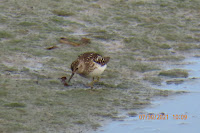Elevation: Flat. Wheelchair: Yes
Popular: but not crowded
NO Dogs. Bathrooms at the trail head.
The Eureka area has such wonderful hiking opportunities. Kay and Nancy, my pole cat friends, took me out to Humboldt Bay National Wildlife Refuge.
This place is an ornithologist's heaven. There are lots of benches to sit and watch birds and all sorts of other stuff go by.
Trail Notes:
- There are clean bathrooms at the trail head. This bird has found a good nesting site over the ladies loo.
- Limited parking with little room for big vehicles.
- You really, really should not even think of taking your dog out here. Their smell frightens animals away.
- There is not a lot of tree cover on much of the trail, but it stays quite cool most of the time here on the bay. But wear a hat and/or sunscreen. You may get much more sun that you are aware.
When the birds migrate north for summer, or south for the winter, this is one of the great stopping points. You can see literally thousands of birds. Just be sure to wear shoes that are easy to clean if the geese are in town. There are also many birds that live in this area year round. Bring your camera.
You leave the area of the visitor’s center over a board walk. You will notice numerous gates as you go along. These regulate the amount of water kept in the slough. When settlers diked and drained this area, they didn’t know that these wetlands are tremendously important in the local ecosystem.
 |
I was honored to meet one of the local residents at one of the larger gates. S/he is a total camera clown.
Not much further along Shorebird Loop trail is a Y in the road. The right hand path is a bit longer. I suggest taking the Left hand path, then if you have energy on the way home, take the other trail.The next Y is at Long Pond which will loop back around, so it really doesn’t matter which way you. You also have the option of doubling back to extend your hike.
Today’s adventure, we took the trail to the right. You will find a bit of old machinery along here. Take notes as you go along so you can research some of the names. The history is still fresh.At the furthest part of the loop, there is an arm of the trail that goes to a boardwalk deck over Hookton Slough. There is another hike on the south side that I plan for next year.
If you look to the other side, way in the distance, you will see trees dotted with white egrets. This is a rookery, a nesting area.
The slough has many different faces. When the tide is out, birds will line the edge where the freshest tidbits hide in the mud.Low tide is also a good time for mammals to come down. Look at the great variety of plants. Each plant has a zone that it likes best. Salt/fresh water. Wet/damp/dry. Sun/shade. As the wetland recovers, the native plants will take hold. Choose one plant family you like to watch for in various locations. Then watch for it as you do other hikes. Kay and I have been looking at Umbelliferae or Apiaceae lately. They vary from toxic to tasty, so know before you eat. I have a personal goal to be able to recognize and name at least 5 wild species.
The Visitors Center host guided walks. Even better, they have evening walks on certain dates.
All photo credits go to yours truly.





















Comments